Transfer Circuit to T-shirt
by push_reset in Circuits > Wearables
3480 Views, 2 Favorites, 0 Comments
Transfer Circuit to T-shirt

You have your final circuit working with the sketch and have figured out where the flex sensor is going to live. Now is the time to rebuild your circuit onto the t-shirt. During the Hi-5 Collector you used conductive thread to build the circuit. This time, you will use a combination of conductive fabric and thread.
You will learn:
+ how to build a circuit using iron-on conductive fabric
Materials

+ iron-on conductive fabric
+ fitted t-shirt
+ USB cord
+ conductive thread
+ regular thread
+ hand needle
+ scissors (or rotary blade with cutting mat)
+ felt
+ Heat 'n' Bond
+ fabric glue
+ straight pins
+ 5 x snaps (socket side)
+ fabric marker or chalk
+ alligator leads
+ iron
---- final project circuit ----
+ snap switch
+ handmade flex sensor
+ resistor for voltage divider circuit
+ vibe board
+ microcontroller
+ LiPo battery
Place Components

Component list for Slouch Alert T-shirt:
1 x LilyPad USB
1 x LiPo battery
1 x vibe board
1 x resistor
1 x handmade flex sensor
1 x snap switch
I've included a diagram using the upper center back with the flex sensor on the left shoulder and the switch on the right. You should already know where the sensor should be placed based on your findings from the Read Body Movements lesson. Use the diagrams to place your components or feel free to make your own layout based on your discoveries. Make sure to snap a photo to share at the end of this lesson.
Clip the battery into the JST connector on the LilyPad USB. Place the LilyPad, vibe board, resistor and battery on the back of the t-shirt. Center everything and put it close to the neckline. The upper back is a good out-of-the-way spot to put protruding components because it's a relatively flat part of the body that doesn't come in contact with other things that often. The other place is the upper torso by the neckline or around the shoulder area. Experiment with placement!

Things to take into consideration when placing your components:
1) Visualize your conductive paths. When possible, do not put a component in a place that will create overlapping paths. There are two points on the diagram where paths do overlap, I will show you how to deal with those in this lesson.
2) Leave room to sew down and around components
3) Are any components polarized?


Trace

Start on the front of the t-shirt.
Put the flex sensor back onto the velcro that was left on the t-shirt. This Velcro needs to be removed before you attach the sensor to the shirt. Carefully peel the sensor back, remove the Velcro underneath and replace the sensor.


Use the fabric pen to trace around the flex sensor and snap switch. Make a dot where each lead of the sensor hits the t-shirt.


Flip the t-shirt over and trace around the LilyPad USB, vibe board and resistor. Make a dot through each hole of the vibe board and mark the ground (-) and power (+) side.
Mark where to connect to the resistor, if your resistor is not on a felt breakout make a mark through each curled-up lead.
On the LilyPad USB mark pin 2, power (+), ground (-), pin A5, and pin 11. Since there is a dark design beneath where my LilyPad is going I used some masking tape to make my marks on.


Draw Circuit: Sensor
When the Hi-5 Collector was built the snaps were sewn on first since you needed to sew the traces to them with conductive thread. This time, you will mark and build the circuit first because the snaps will be placed over the ends of the traces and then sewn to them afterwards.
First, draw the traces that connect the sensor and the resistor to the LilyPad USB.
Then draw the one side of the resistor to the ground (-) pin of the LilyPad.

Draw the other side of the resistor to analog input pin A5.

Draw one lead of the sensor to the same side of the resistor that is connected to pin A5.

Connect the remaining sensor lead to the power (+) pin of the LilyPad.

Draw Circuit: Vibe Board
Now, onto the vibe board. It only has two connections that need to be made.
The power (+) pin of the vibe board to pin 11.

The ground (-) pin of the vibe board to ground (-) of the LilyPad. This trace goes straight down then crosses the trace that goes from the sensor to the power (+) pin. This is ok, I will show you a way to avoid a short circuit when we start building the circuit out of iron-on conductive fabric.


Draw Circuit: Snap Switch
Keep the t-shirt laid out with it's back facing up and fold the shoulder back to get to your marks. Put two marks on the bottom halves of each contact. This is where the conductive fabric traces need to connect to.
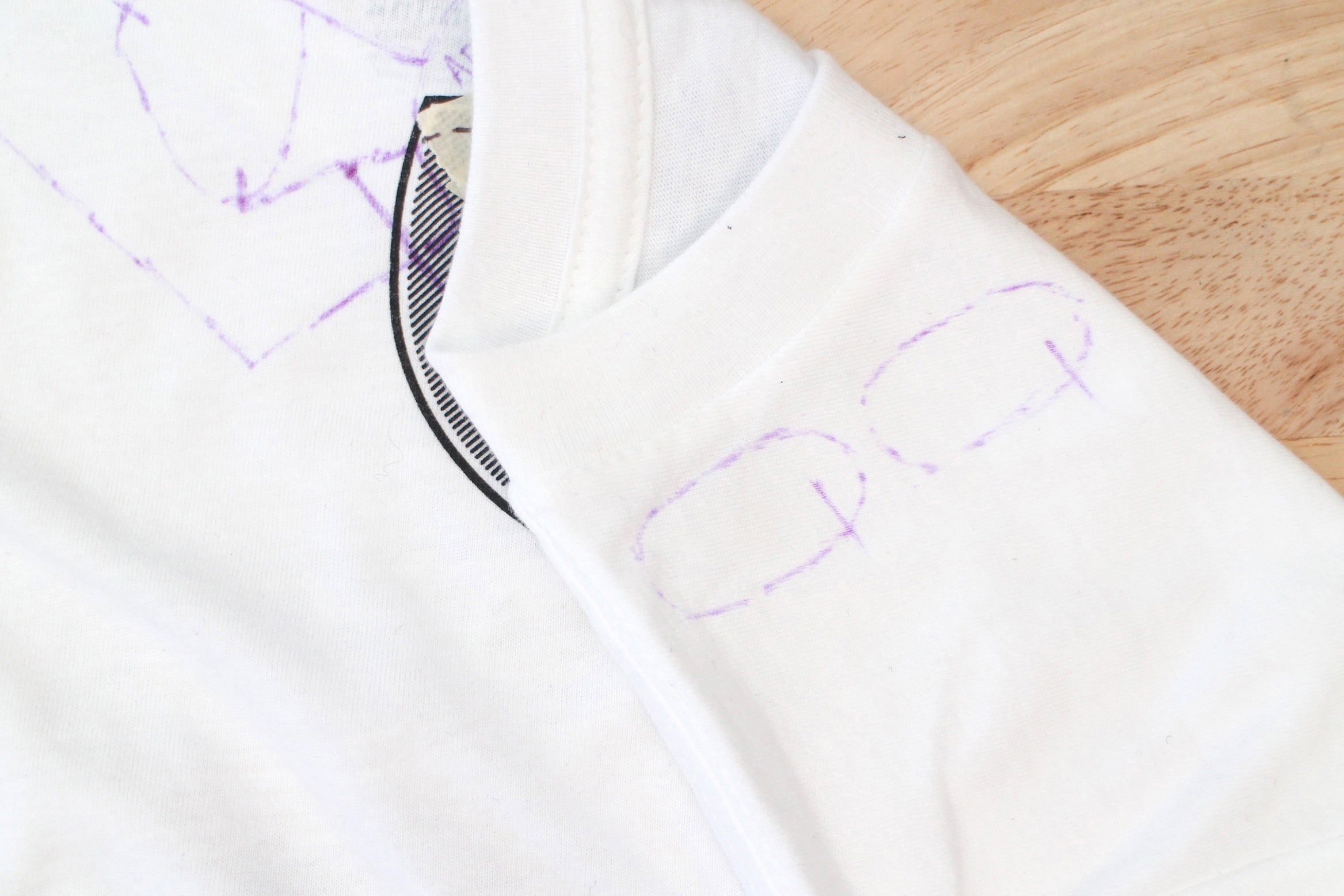
Draw a trace from the first contact to pin 2 of the LilyPad. You will cross another trace which is ok and will be addressed later on.
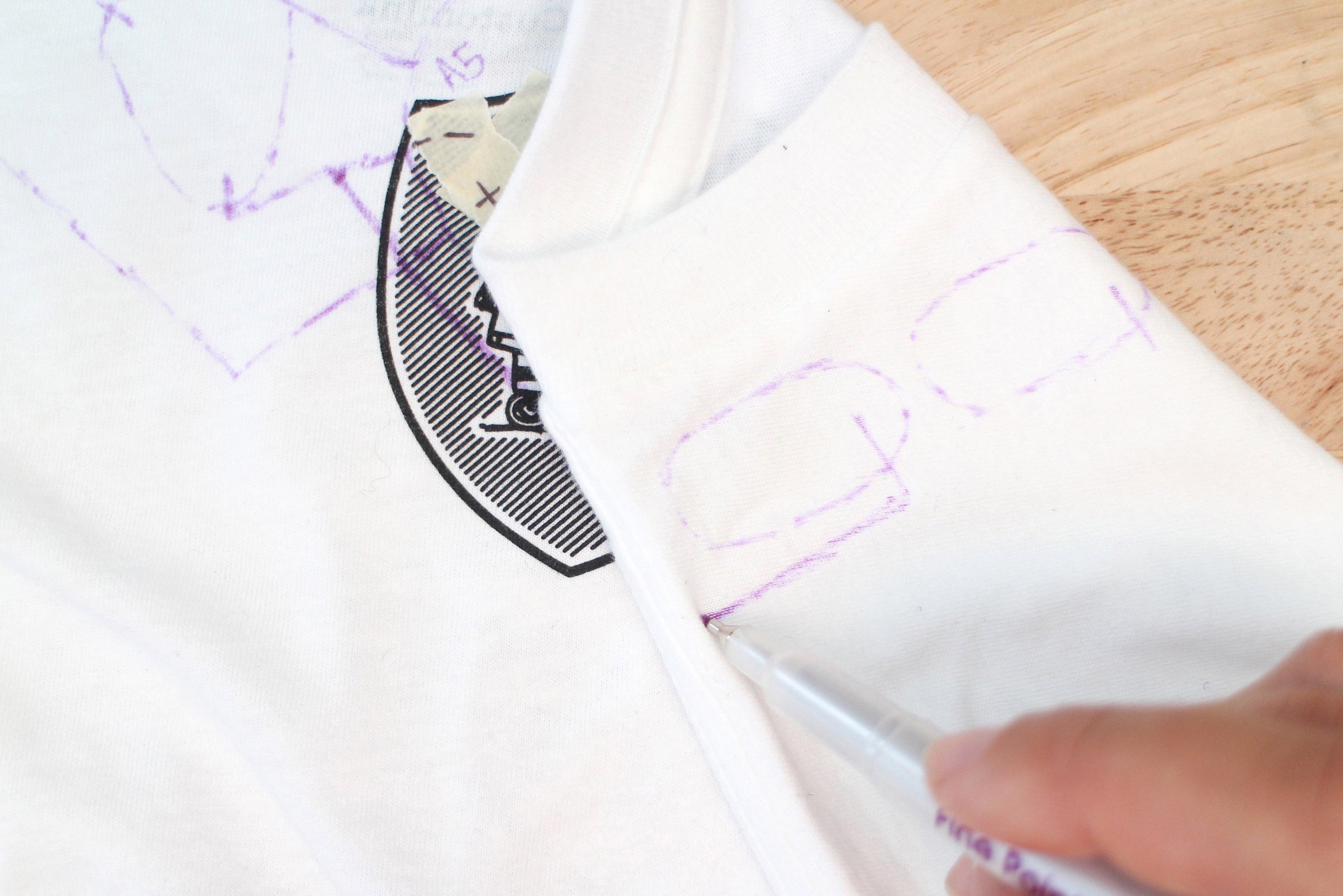


You have one more connection to make. The remaining switch contact gets connected to the ground (-) pin of the LilyPad. Draw and end on the vibe board's trace that is connected to ground. Since they both need to be connected to ground they can share a common ground trace. To differentiate the ground connections from the traces that overlap, make two dots where the snap switch connects to the vibe board ground and where the vibe board connects to the resistor ground.


Final Drawn Circuit
You are done drawing the circuit! You are now ready to build it using iron-on conductive fabric.
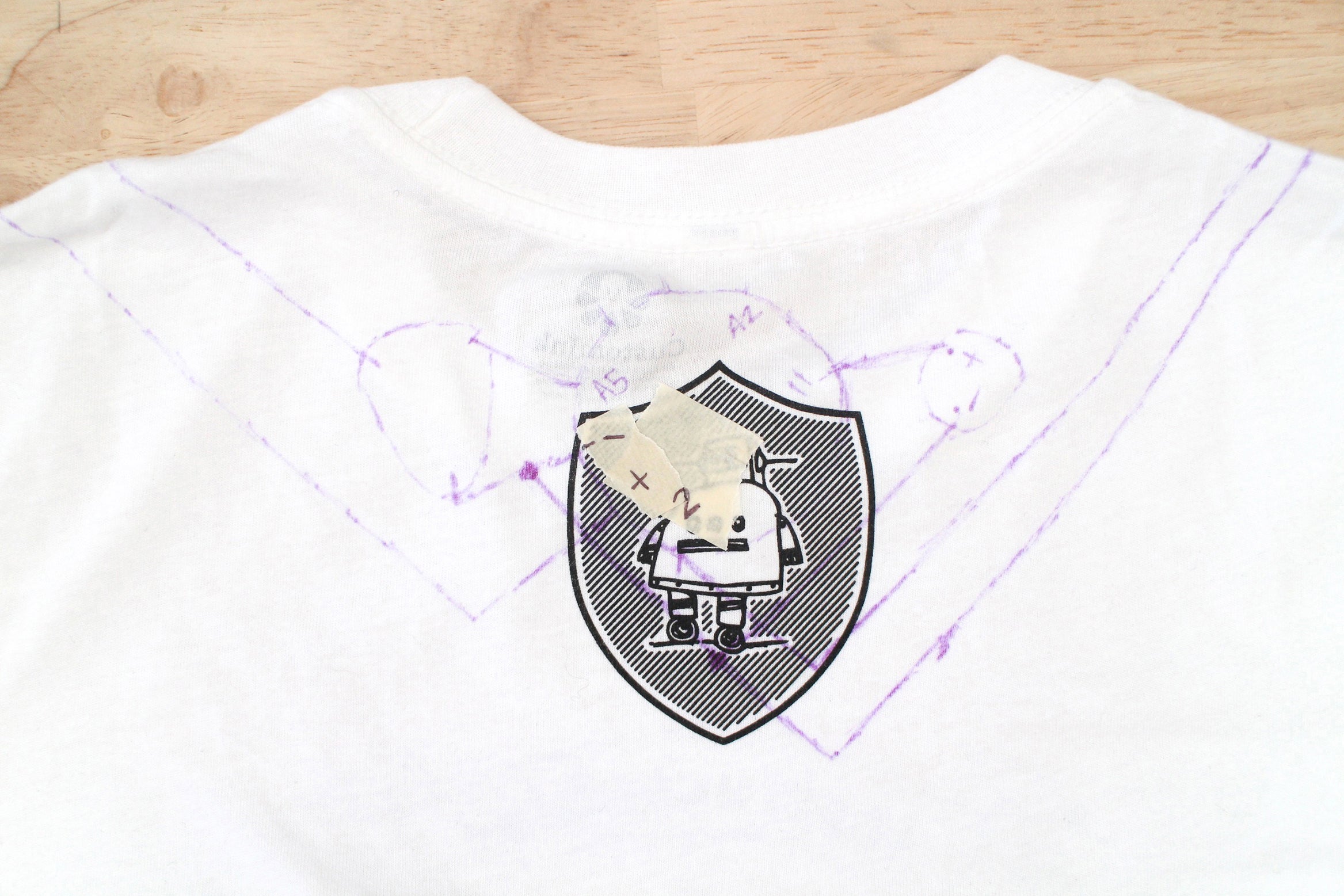

Cut Conductive Fabric

Cut multiple thin strips of iron-on conductive fabric 1/4" wide using scissors or a rotary cutter

Iron-on Circuit: Getting Started
Conductive thread isn't the only conductive fiber-based material you can build soft circuits with, you can also use conductive fabric. Turn your iron on to a medium-high setting, no steam. Let's start with the ground traces. There are two points where traces overlap the ground trace. Let's address this first and get it out of the way.

Cut a piece to the length of your mark.
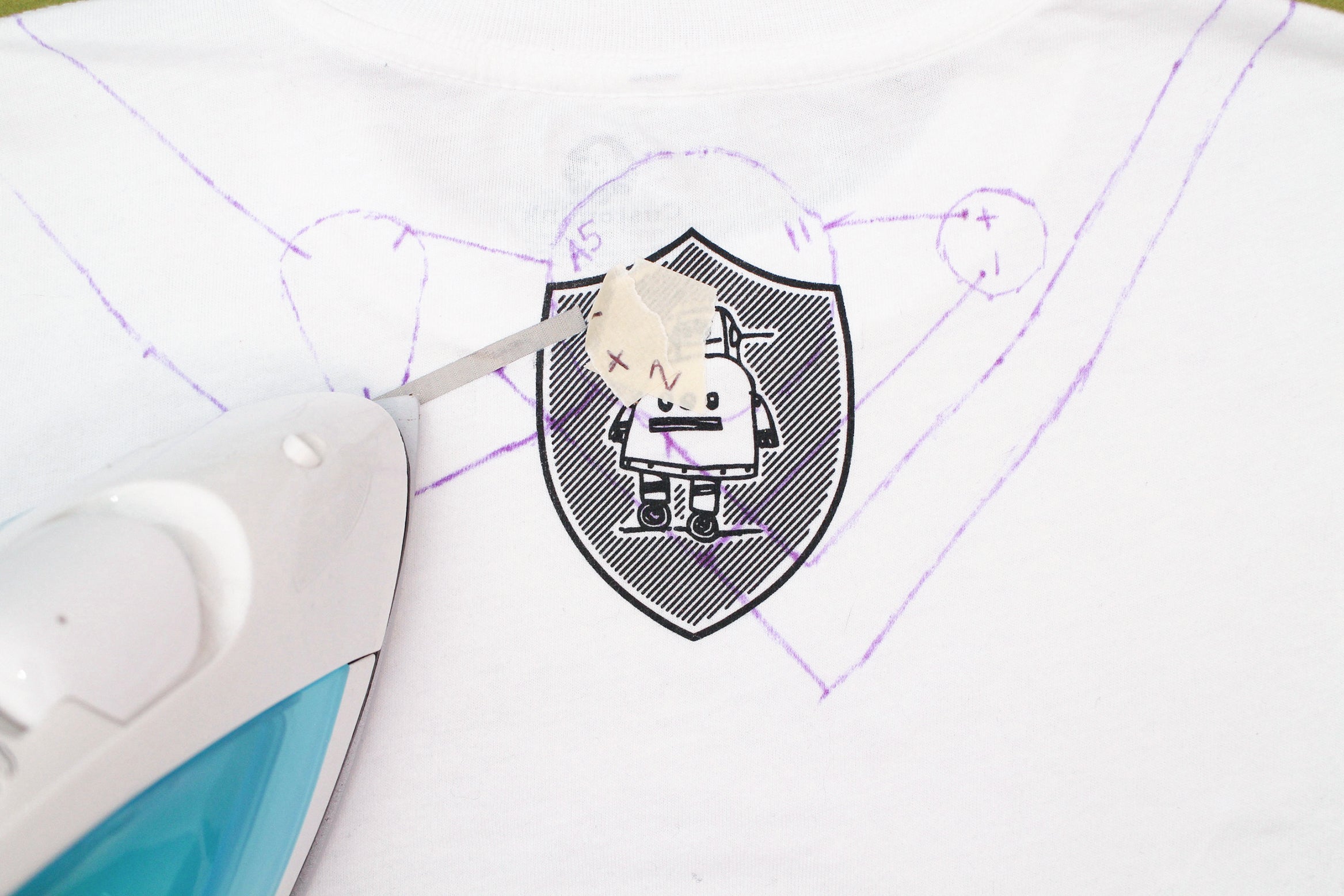
Iron down the first trace connecting the ground of the LilyPad to the resistor.
For the next piece you need to connect two strips of iron-on conductive fabric. Since you are building one trace, these two pieces need to be electrically connected too. This is very easy to do. Simply, overlap the ends of the two strips and iron one on top of the other. This melts the hot-melt adhesive enough for the two pieces of conductive fabric to touch. Always check your connections with the multimeter! Need a refresher on how to do that? Go back to the Sew a Circuit lesson.

Iron down the second piece of the ground trace connecting ground to the snap switch.

Iron on top of where the two strips overlap to create an electrical connection and to continue the trace.

Cut and iron another strip to continue the trace up towards the snap switch, end at the shoulder.
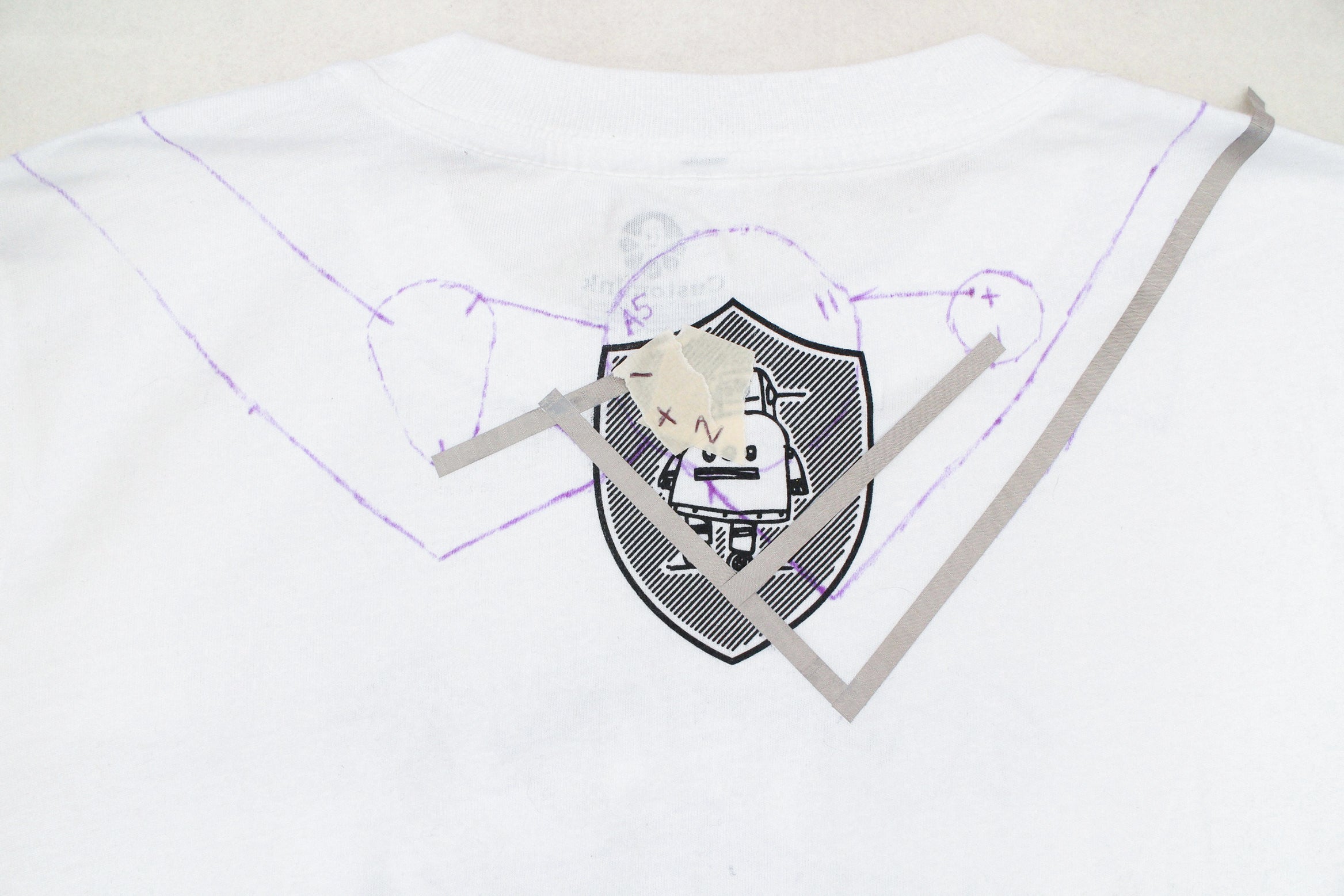
Make the last connection to the ground pin, which is to the vibe board.
Iron-on Circuit: Making Bridges
Now is when we address those two points where traces overlap another. When a trace needs to cross another trace you can make sure that there is no potential for a short circuit. All you need to do is make a barrier between the two traces. I call these barriers bridges since they act like one, allowing one trace to safely run over the trace underneath it.
To make a bridge, iron a strip of Heat 'n' Bond to a strip of felt. Peel off the backing when it cools.


Cut a piece long enough to make a bridge over the trace you need to cross. Here I am making a bridge for the sensor trace that connects to power. It needs to go over the ground trace I have already built.

Cut another bridge for the trace that connects the switch the pin 2.

Iron both bridges down.

Place the trace from pin 2 to the switch as you normally would, except now it goes on top of the bridge. Iron down.

Continue the trace up to the shoulder where it will connect to the switch on the front.

Iron down the second trace from the power (+) pin to the sensor.
Iron-on Circuit: Complete
Continue to iron down the traces to complete the circuit.
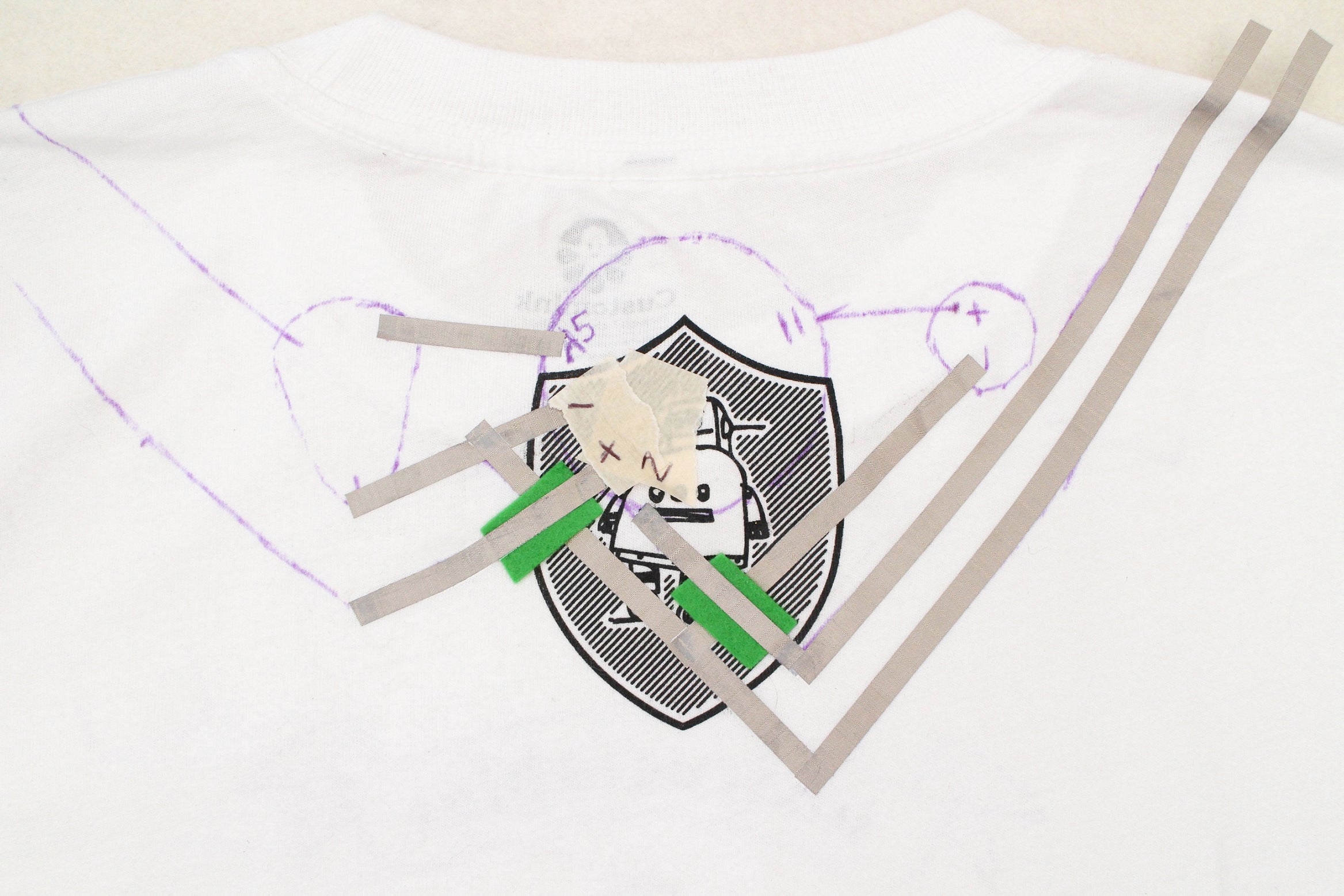
Iron the trace from the resistor to pin A5.

Pin 11 to the power (+) pin of the vibe board.

Resistor to flex sensor.
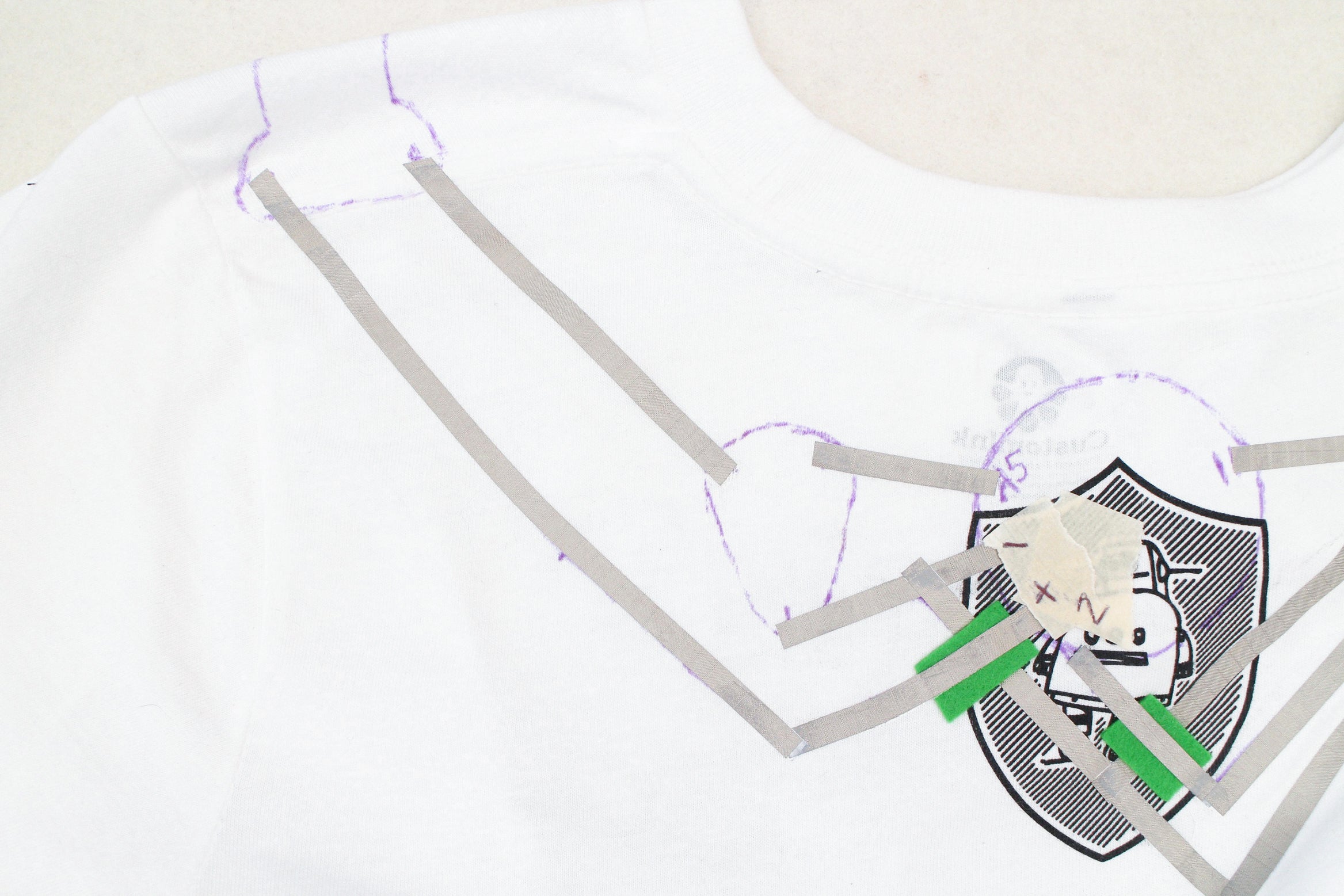
Finish the Power (+) to flex sensor trace if you haven't already.

Lastly, continue the traces to each of the switch's contacts over the shoulder.

Sew Down Flex Sensor
Once the circuit is ironed onto the fabric the components get sewn to their corresponding traces. The goal is to make an electrical connection between the trace and the component using conductive thread. Let's start with the flex sensor.
Pick up your flex sensor and notice how one lead faces down and one faces up. The one that faces down will be hard to get to once the sensor is sewn to the t-shirt. To make contact with the lead that faces down before it's sewn down, sew several small stitches of conductive thread through it.


Now the sensor can be put onto the t-shirt. Put the needle aside while the conductive thread is still coming from the lead of the flex sensor. You will pick up the thread and start sewing again in a minute. Take some straight pins and pin the sensor to the t-shirt to keep it in place. Pick the conductive thread back up and stitch through the end of the trace to connect the sensor to it. Finish with a knot and cut the thread. You have made your first sewn connection! Grab your multimeter and test it to see if it's good.
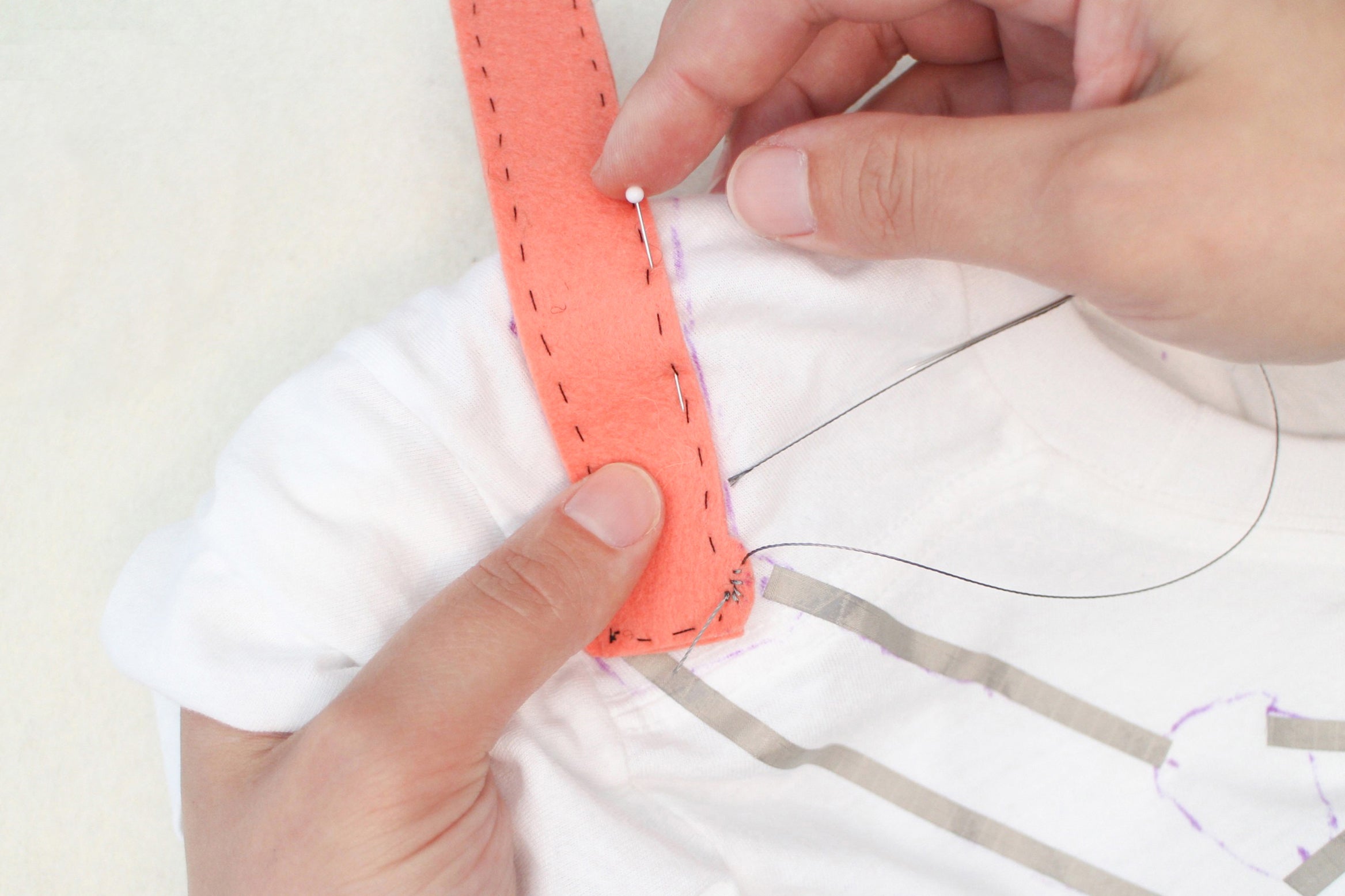


Move on and stitch around the second lead then connect it to its matching trace going to the LilyPad's power (+) pin.
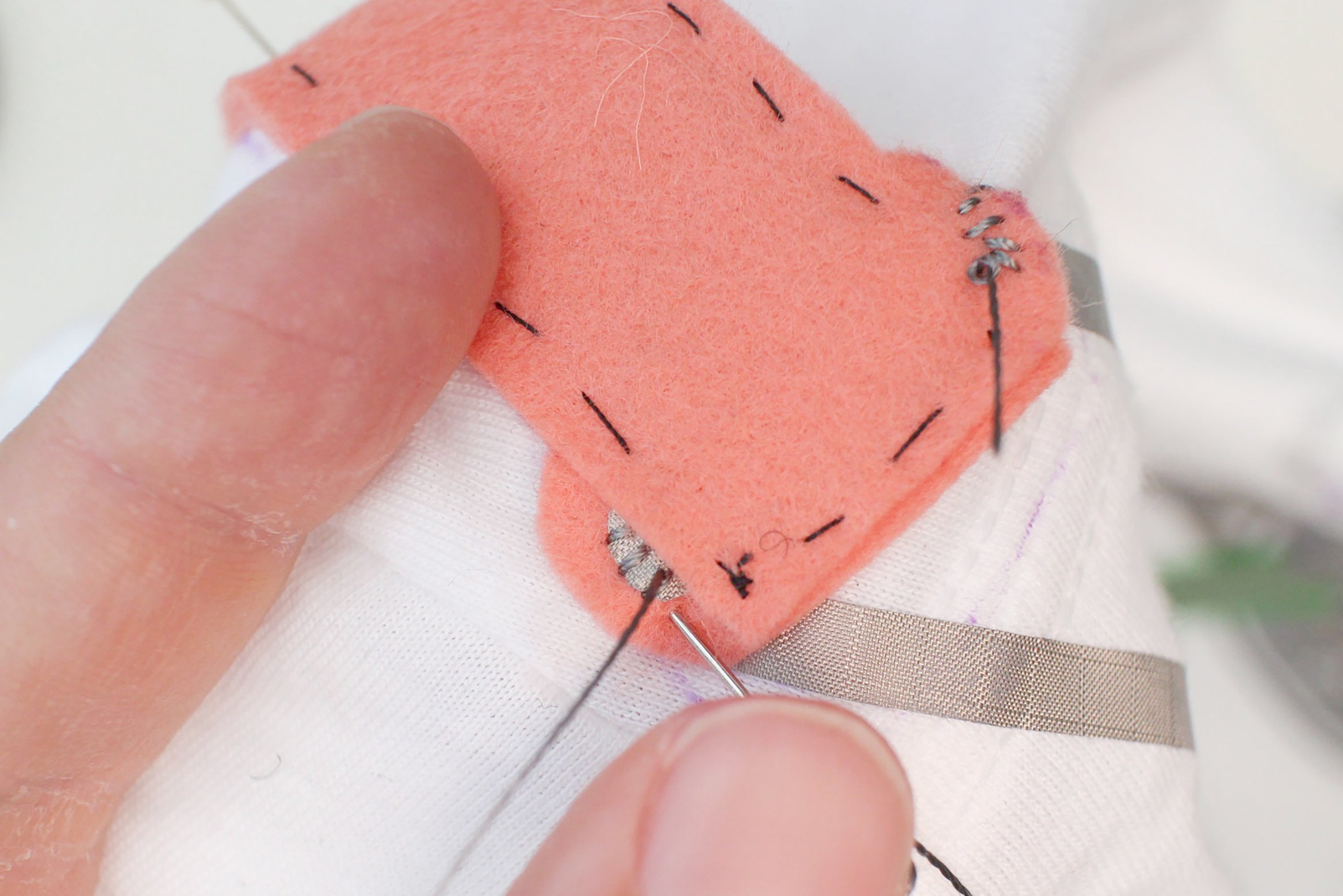

While pinned in place sew the sensor to the t-shirt using a running stitch and regular thread.


Sewn Down Resistor
If your resistor is on a felt breakout, pin it in place to the t-shirt. Otherwise, hold it down with your thumb and forefinger while you sew it down. Make stitches through each lead of the resistor then onto each trace that you are connecting it to. Remember to check your connections with the multimeter!


Sew Down Vibe Board
Before sewing the vibe board down, turn it over and look at the bottom. The power and ground pins have a metal underside. This comes in handy when making connections since the metal can make an electrical connection just by sitting on top of the trace.
Overlap the metal pins with their matching traces (it's polarized!) and sew down with conductive thread using small and tight stitches.

The power and ground pins extend to the bottom of the vibe board.

Place the metal pads over the traces for a better electrical connection. Sew down using small and tight stitches.
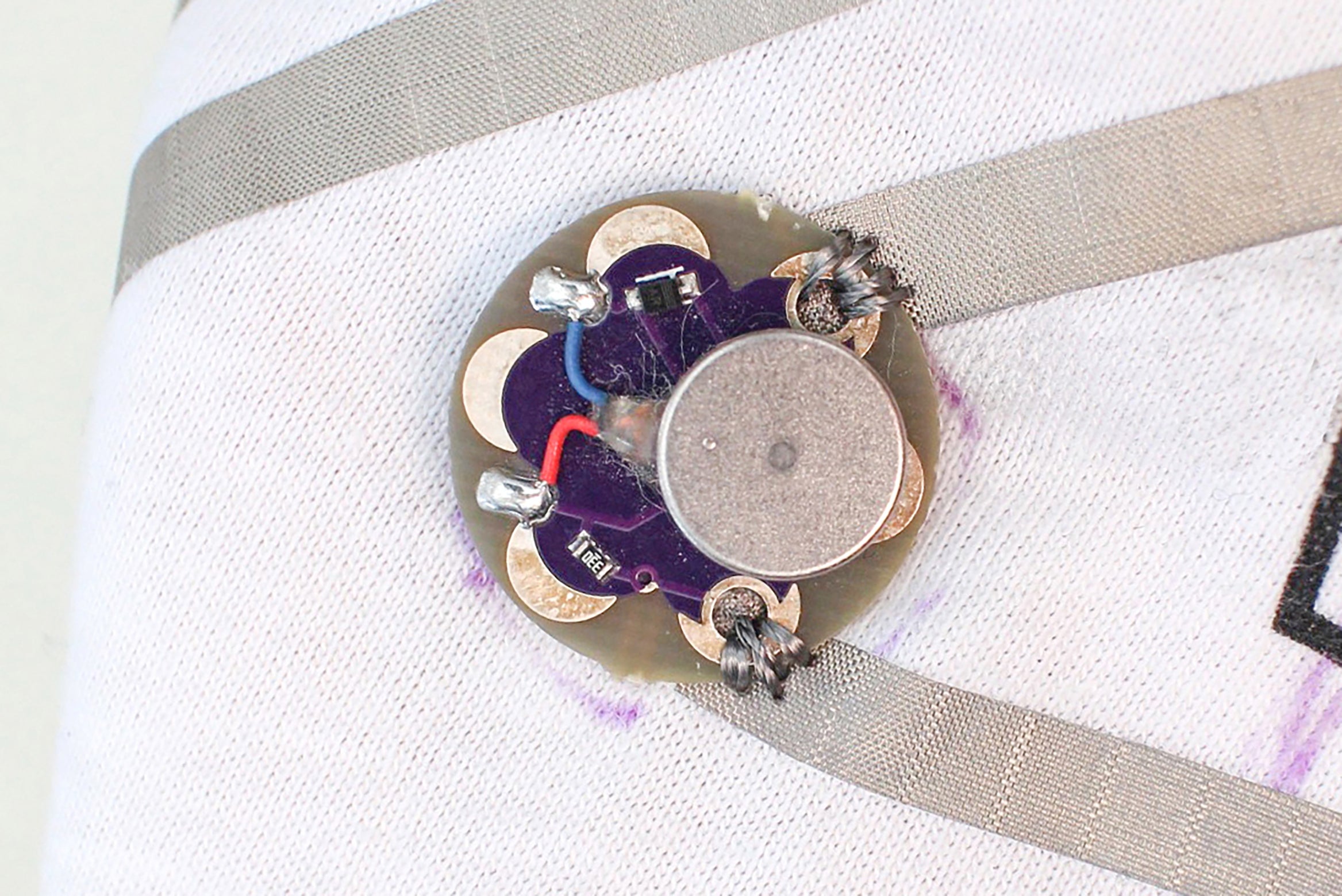
Sew Down Snap Switch
Before you sew the switch to its traces, the two contacts need to be sewn to the t-shirt. Pin the two switch halves to the fabric. While pinned, check to make sure that when the top half is folded down it can reach and snap into the bottom half.

Use a running stitch to sew the switch down. Sew the top half about a quarter of the way up so it can fold down and snap into the bottom half.


Now you are ready to make the electrical connections. Grab your conductive thread and sew each contact to its trace.
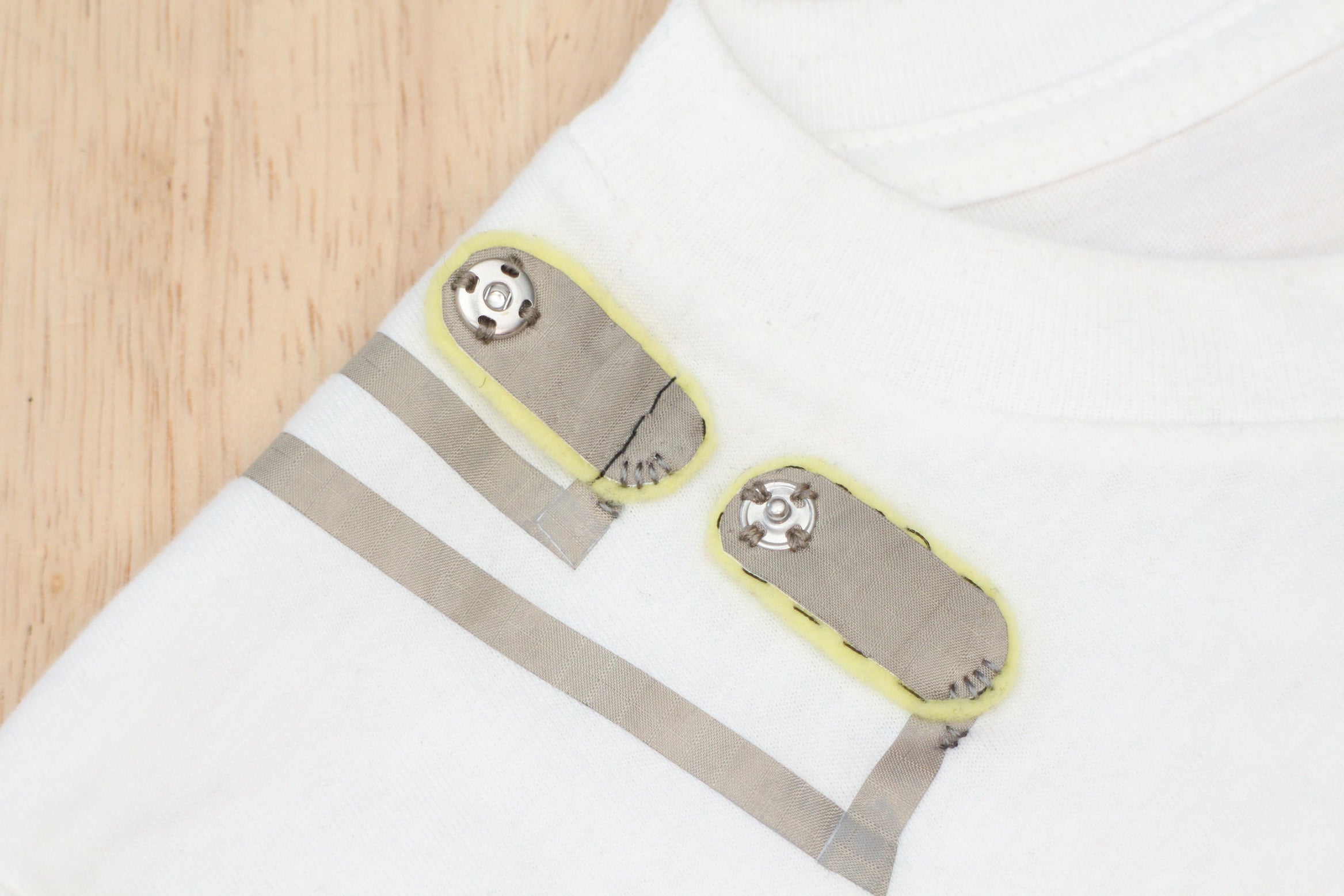
Mark Snaps

The circuit is complete! Well... almost. :)
The snaps still need to be sewn down. Grab the LilyPad, line up the pins 11, A5, 2, power and ground with the fabric traces and mark where the center of the snaps hit the t-shirt.
Sew Snaps

Center each snap over the marks and sew down using regular thread. The snap should overlap the end of the trace. After each snap is sewn with regular thread use conductive thread to finish connecting each snap to their trace. Check all the connections with the multimeter.



Sew Battery Pocket

One last thing, you are almost there!
Snap the LilyPad onto the shirt and plug the LiPo battery into the board. Place it directly below the LilyPad and find a spot where it fits and is centered.
Cut a 2.25" x 2.5" rectangle for the pocket and pin it over the battery. Use a running stitch to sew the pocket to the t-shirt.




Secure and Trim

Go to the inside of the t-shirt where all the conductive thread knots are. Tighten the knots up, put some glue on them and wait for them to dry. Use the glue to cover all the other exposed stitches of conductive thread inside the shirt. Cut off all the conductive thread and regular thread tails.
There is no step to cover the outside of the circuit, it is left bare! I really like the aesthetic of ironed on circuits, what do you think? Of course, if you choose to protect it you can use any of the learned techniques or come up with your own!
Circuit Is Complete!

You are done! Woohoo! Great job. Make sure to use the multimeter on the continuity setting to test all of your ironed and sewn connections if you haven't already. The next lesson is the final one for the Slouch Alert project. You will test and calibrate it while on the body. You will also learn how to turn the LilyPad USB into a keyboard that triggers sound files.

Test Your Knowledge
{
"id": "quiz-1",
"question": "To make an electrical connections between two pieces of iron-on fabric you…",
"answers": [
{
"title": "Overlap and iron two ends together",
"correct": false
},
{
"title": "Sew the two ends together using conductive thread",
"correct": false
},
{
"title": "Both are correct",
"correct": true
}
],
"correctNotice": "That's correct",
"incorrectNotice": "That's incorrect"
}
{
"id": "quiz-2",
"question": "How many times should you test your sewn and ironed electrical connections?",
"answers": [
{
"title": "All the time",
"correct": true
},
{
"title": "Always and forever",
"correct": true
},
{
"title": "The opposite of never ",
"correct": true
}
],
"correctNotice": "That's correct",
"incorrectNotice": "That's incorrect"
}
Share a photo of your fresh and finished soft circuit below!